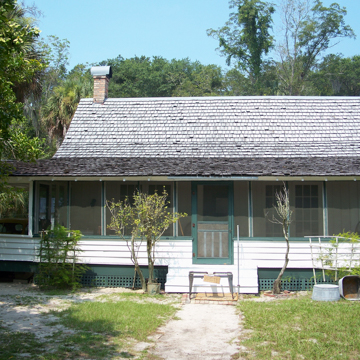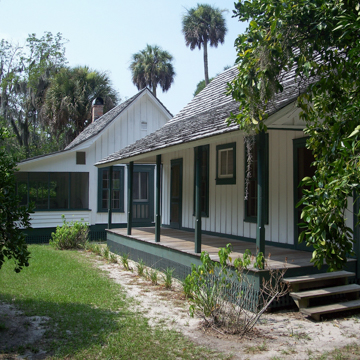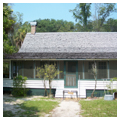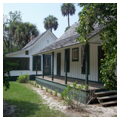You are here
Marjorie Kinnan Rawlings Historic State Park
American writer Marjorie Kinnan Rawlings lived in this house from 1928, when she moved to Cross Creek, until her death in 1953. The original wood frame house from the 1880s consisted of two rooms separated by an open breezeway down the middle behind the front door. Between 1890 and 1925, the structure underwent several significant modifications. Two bedrooms were added to the west side of the original building, a kitchen/dining room wing was added to the west beyond that, and a two-bedroom structure was added several feet to the north of the original house. Rawlings herself made several critical transformations to the existing property that helped it to become a unified collection of disparate parts and pieces. She had a bathroom constructed that connected the north bedroom wing to the original structure and then had a second bathroom constructed off the north end of the north wing, directly off what Rawlings used as her master bedroom. At the far south side of the original structure, as a bookend to the modern bathroom on the north, Rawlings added a carport that housed her 1940 Oldsmobile.
The house and grounds are carved out of an orange grove that provided the basis of a working farm that included livestock and vegetable gardens. The path from the front door leads out to a paved rural street in this portion of unincorporated Alachua County, about twenty miles southeast of Gainesville.
Rawlings gained fame as one of the great storytellers of the American South. She had grown up in the South, but lived as a young adult in the Midwest and Northeast, ultimately moving from Rochester, New York, to Cross Creek. The majority of her literary output was created at the house in Cross Creek, including her famous 1938 Pulitzer Prize–winning national bestseller The Yearling. Rawlings’ writings wove detailed descriptions of the people and places she encountered in central Florida into larger narratives about the perils and complexities of modern life and human identity. Although writing before the rise of the civil rights movement and benefitting from the advantages of low-wage African American staff members, Rawlings expressed what were then considered progressive views about race. She befriended fellow writer Zora Neale Hurston and successfully encouraged her literary agent to pick up Hurston’s work.
Rawlings’ house and grounds in Cross Creek can be understood as analogies of her literary achievements in connecting regional to universal issues. As modified by Rawlings, the house featured porches that opened to the breezes on the south and east sides of the building, one of which served as the location of her typewriter, the source of her fortune and fame. Where possible—and added where needed—Rawlings kept vertical board-and-batten paneling, although she changed the original color from gray-green to a more modern bright white. While she retained the historic outhouse on the site (in direct view of the dining room), she added modern toilets, bathtubs, and a shower inside. To maintain staff support for the adequate functioning of the property as a writer’s refuge, a refined literary social center, and a local working farm, Rawlings added a tenant house in 1934.
The Rawlings House, together with the tenant house, barn, pump house, gardens, groves, and other outbuildings, forms a collage of past and future, regional and local that point to the complexities and paradoxes of the author herself and the place and time in which she wrote. After Rawlings’ death, the house was bequeathed to what is now the University of Florida Foundation. Since that time, the house and grounds have been managed by the state.
References
Laurie, Murray D., “Marjorie Kinnan Rawlings House and Farm Yard,” Alachua County, Florida. National Register of Historic Places Landmark Nomination Form, 2006. National Park Service, U.S. Department of the Interior, Washington, D.C.
McDermott, John, “Marjorie Kinnan Rawlings House and Farm Yard,” Alachua County, Florida. National Register of Historic Places Inventory–Nomination Form, 1970. National Park Service, U.S. Department of the Interior, Washington, D.C.
Rawlings, Marjorie Kinnan. Cross Creek. New York: Charles Scribner, 1942.
Sharpless, Rebecca. “The Servants and Mrs. Rawlings: Martha Mickens and African American Life at Cross Creek.” The Florida Historical Quarterly 89, no. 4 (Spring 2011): 500-529.
Writing Credits
If SAH Archipedia has been useful to you, please consider supporting it.
SAH Archipedia tells the story of the United States through its buildings, landscapes, and cities. This freely available resource empowers the public with authoritative knowledge that deepens their understanding and appreciation of the built environment. But the Society of Architectural Historians, which created SAH Archipedia with University of Virginia Press, needs your support to maintain the high-caliber research, writing, photography, cartography, editing, design, and programming that make SAH Archipedia a trusted online resource available to all who value the history of place, heritage tourism, and learning.








